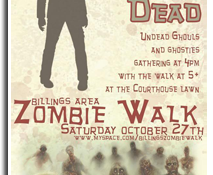Thirty years ago, I got hooked on George Romero’s Dead movies, starting with Night of the Living Dead. And I enjoyed the 2004 spoof Shaun of the Dead. Now, the sub-genre lives on through the new movie, Zombieland.
Some critics consider these Dead movies to be a fitting metaphor for our times—the idea that zombies return from the dead to eat the living! It is entertaining to see how this idea is channeled through the creative talents of regular folks, such as one of my clients, Morris R., who helps organize a local Zombie walk each year in October. See if you can spot him in the video—he’s the one in the black suit with the red tie and dangling eyeball!
Zombie walks recreate key scenes and ideas from zombie movies. For example, as the credits roll at the beginning of Shaun of the Dead, your eyes follow the camera panning right through scenes of regular people moving supermarket trolleys, working behind tills, waiting at the bus stop, or mindlessly listening to street music, all staring and acting zombie-like. At the end of the movie, when the zombies have taken over, the camera does the same thing again, underscoring the point that nothing has REALLY changed—zombies now and forever!
Every time I see such scenes, I am reminded of clients who come to me in a state of calamity, including a local teacher who was desperate to find a better job fit. He said, “I come alive in summer. The rest of the year I am dead, a walking zombie, going through the motions of life.”
The living in these zombie movies are often characterized as people living in various states of limitation—making them easy targets for the Undead. Some are physically handicapped, others suffer from poverty, while others are stuck in institutions, or trapped in specific social settings, such as a mall or a amusement park. Others manage to escape a gruesome fate, but only for a short time, before their fears, beliefs, doubts or assumptions put them in the path of the flesh-eaters. In the end, they all fall victim to the insatiable appetites of zombies.
Limitations are part of the reality we don’t like. How much easier life would be if we could remove the barriers to career advancement and shoot forward into success! In Zombieland, the main characters literally shoot their way through the barriers posed by the Undead.
Many of us simply surrender to the circumstances in which we find ourselves. If zombies surround us, why fight them, it’s easier to join them. Today, the number one workplace disability is depression. Millions of workers in North America cope with job stress and dissatisfaction by popping pills that have zombie-like side effects.
We can also react to negative situations with flight or fight. We might run from the zombies or beat them off…but then what? Being creatures of habit, it is too easy to backslide into our previous zombie-like existence—the exact point made in Shaun of the Dead.
Paul Tillich, a 20th C. philosopher, said “Courage is the affirmation of one’s essential nature.” When we have the courage to really live, we find joy, for as Tillich says, “Joy is the emotional expression of the courageous ‘YES to one’s own true being.” This takes courage in a world where choices have trade-offs.
Making hard choices is the essence of the hero’s story in any movie, including the Dead ones. How do you start being less fearful? How do you keep from falling back in the same old decision patterns? In my experience, the only way out of the career trap is through it.
It takes courage to honor the ambiguity that accompanies any transition process. We oscillate between hope and fear when we go from childhood to adolescence; from a student to a worker; from a single to a married person; from a childless adult to a parent–they all require some faith in the process of life.
This is the choice : life or zombieland.
If you’re stuck in zombieland, you need to break out. Now is the time to explore options with an emboldened heart and an open mind.
The zombie movies remind us that our fears sometimes force us to retreat to what is familiar. We keep doing what we’ve always done. Habitual behavior creates a comfort zone. You may not enjoy your job duties but at least they are familiar. Better the zombie you know than the zombie you don’t know.
Now is the time to rise up and smite that zombie on the nose. Choose life! Break out of Zombieland today!

